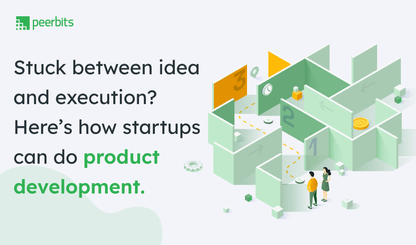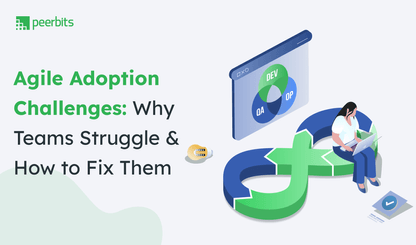Digital transformation in healthcare is becoming essential as providers deal with growing complexity, rising patient expectations, and the need for faster, data-driven care.
It is about building smarter and more connected healthcare system not just automation, to support real-time decisions and improve outcomes.
Backed by growing adoption of cloud-based healthcare systems and government support, the global digital transformation in healthcare market is expected to reach USD 86.03 billion in 2025 and grow to around USD 351.71 billion by 2035, according to Future Market Insights.
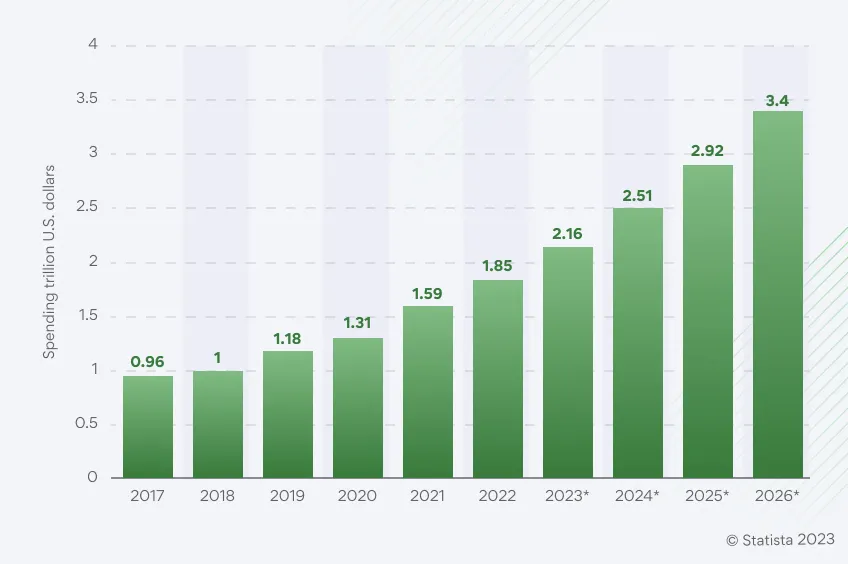
In this blog, we’ll look at current trends, challenges, and practical solutions shaping healthcare’s digital transformation, helping you plan smarter, scale faster, and deliver better care.
What is Digital Transformation in Healthcare?
Digital transformation healthcare software development is making use of the latest technology stack, methodologies, and processes to deliver sustainable value to patients, healthcare professionals, and healthcare organizations.
It’s basically about embracing and employing advanced technologies and innovative approaches to maximize benefits. Some key goals of digital transformation include improved patient outcomes, lower costs, increased accessibility, and better experiences for both patients and providers.
Let’s check out the benefits of digital transformation in healthcare for patients, healthcare institutes/organizations, and the healthcare industry as a whole.
Benefits of Digital Transformation For Patients
Digital transformation provides significant advantages to patients through digital healthcare solutions. Let’s check them out below.
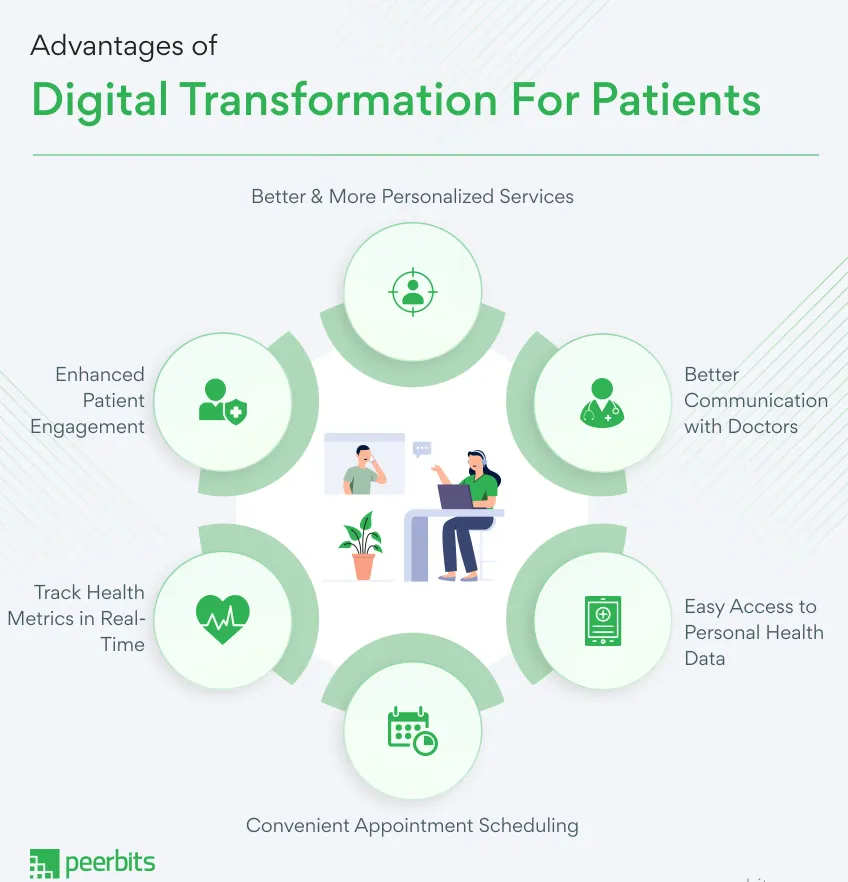
Better & More Personalized Services
The implementation of digital transformation in healthcare enables more accurate health diagnoses and even better & more effective as well as personalized treatment.
Better Communication with Doctors
With digital transformation, patients can obtain professional healthcare services online through video calls, chatting, treatment strategies, and receive clear prescriptions over the healthcare portal or email.
Easy Access to Personal Health Data
Patients can easily access and manage their personal health records and even conduct a thorough analysis of their health metrics online.
Convenient Appointment Scheduling
Digital transformation in healthcare enables patients to schedule doctor’s appointments at the most convenient date.
Track Health Metrics in Real-Time
The use of advanced technologies like Health Wearables allows patients to track their important health metrics in real time.
Remote patient monitoring system
A remote patient monitoring system extends care beyond the hospital by continuously tracking patient vitals at home. It helps identify early signs of deterioration, supports timely interventions, and reduces unnecessary hospital visits particularly useful for chronic condition management.
Enhanced Patient Engagement
Digital health tools allow patients to more actively participate in managing their health by accessing their records, connecting with providers, and using data to make informed decisions about their care. This leads to better health outcomes.
Benefits of Digital Transformation for Healthcare Institutes/Organizations
It’s clear that healthcare digital transformation brings impressive benefits to patients.
But what are the benefits healthcare institutes and organizations get from it?
Let’s find out!
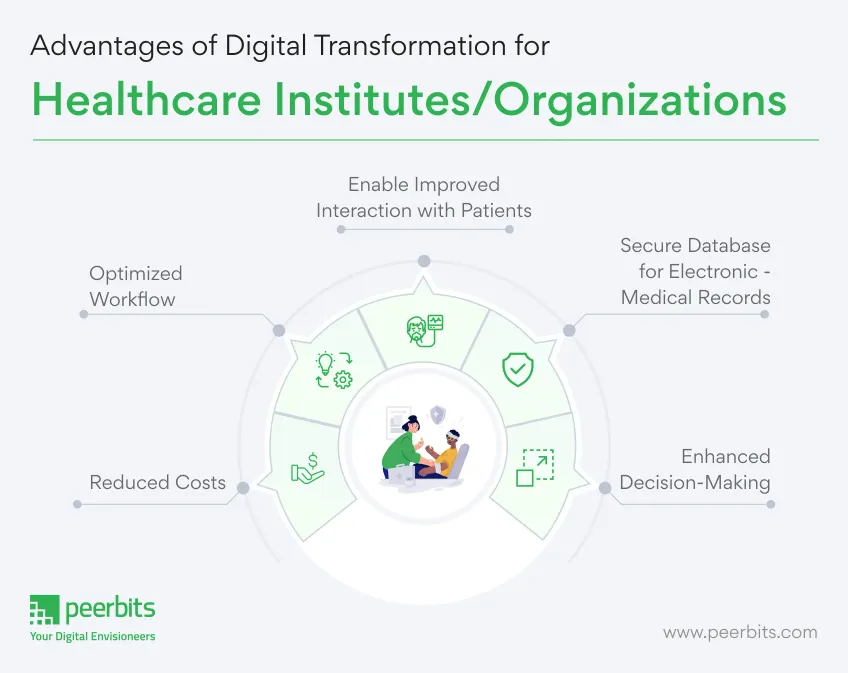
Reduced Costs
Digital transformation enables process automation which in turn lets healthcare institutes & organizations offer cost-effective services and eliminate unnecessary spending in traditional healthcare services.
Optimized Workflow
Digital transformation can replace paperwork with digital records, reduce the patient examination time, and allow easier & optimized access to patient health records.
Enable Improved Interaction with Patients
Digital transformation can enable improved and more effective online interaction with patients via video calls & chats.
Secure Database for Electronic Medical Records
Digital transformation in healthcare allows you to create a secure database for encrypting, storing, and accessing private medical records of patients and enables sharing them on-demand with healthcare professionals, laboratories, and medical specialists.
Enhanced Decision-Making
Digital transformation provides healthcare organizations access to more complete, timely and accurate patient data. This enables better clinical decision-making and care coordination by providers.
Benefits of Digital Transformation for the Healthcare Industry
As you just saw, digital transformation in healthcare provides plenty of benefits for both patients as well as healthcare institutes & organizations.
With digital transformation innovations, in fact, the entire healthcare industry will gain unmatchable benefits and grow to the next level.
Following are some of the main benefits of digital transformation for the healthcare industry as a whole.
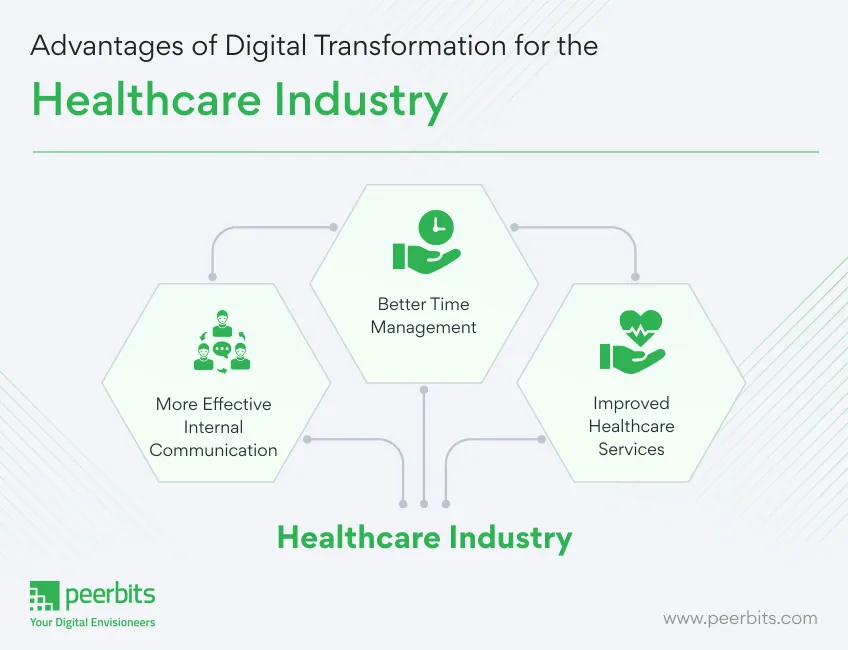
More Effective Internal Communication
The whole healthcare industry relies largely on communication to provide patients with proper care. And digital transformation enables more efficient & smooth communication between all stakeholders.
Better Time Management
Digital transformation can significant amount of valuable time in the healthcare industry. This, as a result, can save numerous lives, thanks to the 24/7 accessibility to the patient’s health records and real-time coordination.
Improved Healthcare Services
The healthcare industry is patient-centric and therefore it is essential to leverage advanced procedures for precise & proper diagnosis and treatment.
Digital transformation lets integrating various technologies enable healthcare professionals & institutes to provide more effective as well as personalized treatment to patients.

Top 7 Digital Transformation Trends in Healthcare
Based on what we just learned, it’s clear that Digital Transformation in Healthcare can substantially improve the ability of healthcare professionals, institutions, and organizations to provide better treatment to patients and help them live healthier and longer lives.
That being said, let’s look at some of the top digital transformation trends in healthcare you should keep an eye on if you’re from the healthcare industry.
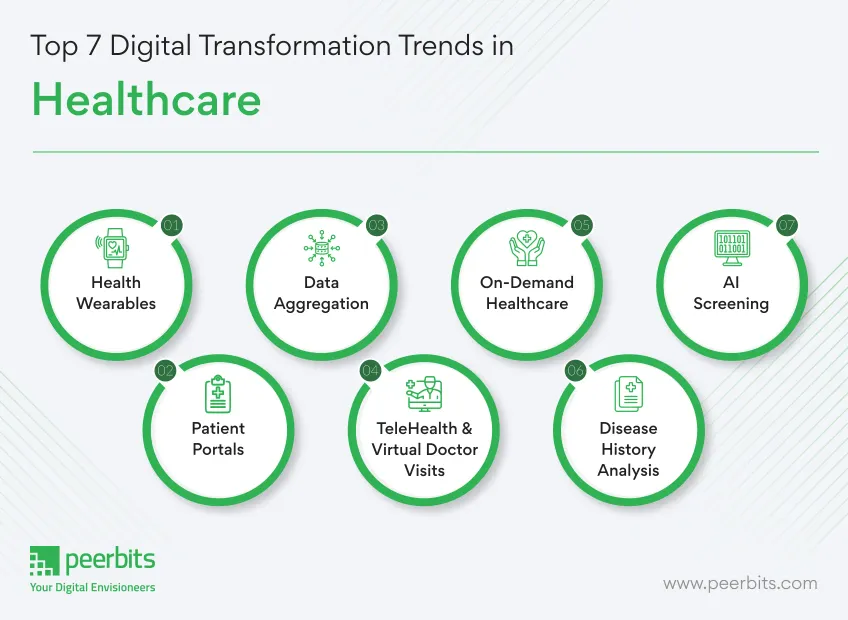
Health Wearables
In the past, people were content with annual checkups and only visited doctors when something went wrong. Today, the focus has shifted. Patients now want regular updates on their health and are actively working to monitor it themselves.
That’s why wearable technology has become a part of everyday life. People are using devices that track key health metrics, giving them early signals and helping them stay ahead of major health issues.
According to Mordor Intelligence, the health wearable device market is expected to reach $493.26 billion by 2030, up from $219.30 billion in 2025. This growth reflects how users now expect technology to play a consistent role in their daily wellness routine.
Popular examples of health wearables include:
- Fitness bands
- Exercise trackers
- Oximeters
- Sweat meters (for tracking blood sugar levels in diabetic patients)
These devices are they’re connected, often forming part of larger systems powered by IoT in healthcare. This connectivity enables real-time data transmission between patients and care providers, giving doctors a more accurate and continuous view of a patient’s health status.
A good example is the Apple watch.
A man fell off his electric bike and lost consciousness. His Apple Watch automatically detected the fall, shared his location, and alerted emergency responders. When they arrived, they found him injured and bleeding on the street. The quick response helped save his life, all because of a connected wearable.
Patient Portals
Another leading trend in digital transformation in healthcare is the growing use of patient portals. These are secure online platforms that let patients access their health records, book appointments, message doctors, and manage various aspects of their care, all from one place.
The value of patient portals lies in their ability to make healthcare more transparent and convenient. Patients no longer have to call clinics for basic info or carry paper records.
Instead, they can review prescriptions, lab reports, and doctor visit notes directly online. They can also share their health data easily with other providers when switching doctors or getting second opinions.
According to Research and Markets, the global Patient portals market was valued at USD 3.92 billion in 2024 and is projected to reach USD 8.38 billion by 2030, growing at a CAGR of 13.50%. This growth reflects the rising demand for tools that help patients stay more engaged in their care journey.
A good example is FollowMyHealth, a widely-used platform in the U.S. It lets users keep track of both general and specialist visits, manage prescriptions, and message doctors directly.
From the provider’s side, doctors can access a patient’s complete medical history in one place, making it easier to offer timely and personalized care.
Data Aggregation
Although, patient portals are a perfect solution to collect patients’ data. But nowadays, healthcare institutions & organizations also need to aggregate those data.
This is mainly because most hospitals nowadays have massive amounts of data coming in from a wide range of sources such as:
- Patient-provided data
- Lab results
- Pharmacy data
- Internal & external electronic health records (EHR)
- Data from medical devices like health wearables
- Imaging data
- And insurance claims
Now, when you’ve data coming in from multiple sources, sometimes, important patient data might get overlooked.
Data Aggregation, however, can help hospitals make quick & insightful patient-care decisions without having to worry about missing important patient data.
Put another way, data aggregation helps to improve patient care and lower costs.
It basically brings together all data to create a thorough patient profile, which drastically reduces the time spent through patient data, resulting in lower patient wait times.
IBM Watson, for example, is an advanced data collection and analysis platform. It is basically a universal solution for multiple industries, including healthcare.
Recently, IBM Watson partnered with Pfizer to develop new cancer drugs by collecting & utilizing cancer patients’ natural immune responses.
Thanks to IBM Watson, two companies were successful in predicting specific kinds of cancer by interpreting complex genomic data.
TeleHealth & Virtual Doctor Visits
Telehealth has become a key component in modern healthcare delivery. With virtual doctor consultations, patients can connect with healthcare providers through video calls, allowing for faster access to care without the need for in-person visits.
This shift isn’t just about convenience, it is reshaping care models and creating new digital touchpoints. One major contributor to this growth is the rising use of telemedicine apps, which make it easier for patients to book appointments, receive prescriptions, and follow up with doctors right from their phones.
According to Statista, revenue in the virtual doctor consultations market is projected to reach USD 10.14 billion in 2025, with a CAGR of 3.25% expected to push it to USD 11.52 billion by 2029. This trend reflects a steady increase in user trust and adoption of virtual care solutions.
On a functional level, virtual visits help doctors manage patient flow better, reduce unnecessary travel, and reserve in-person consultations for cases that truly need them. For patients, it means no more waiting rooms just timely, accessible care through connected devices.
On-Demand Healthcare
The demand for flexibility and instant access has completely reshaped how healthcare services are delivered today. With users expecting care on their terms, healthcare has steadily moved into the on-demand economy.
A major part of this shift is being driven by mHealth apps, which are providing patients and professionals with more connected, responsive, and accessible healthcare experiences.
According to Precedence Research, the global mHealth apps market is estimated to be USD 43.13 billion in 2025, and it’s projected to reach around USD 154.12 billion by 2034, growing at a CAGR of 15.20%.
With this growth, many healthcare providers and startups are now investing in mHealth app development to meet rising expectations, improve patient engagement, and stay ahead in a competitive digital healthcare space.
But it’s not just patients driving this shift. Healthcare professionals are also seeking more flexibility. Many doctors now prefer working with multiple healthcare providers instead of staying tied to a single organization.
To support this evolving model, Nomad Health introduced an on-demand healthcare platform that connects doctors to short-term work opportunities across various institutions.
It gives medical professionals more control over their time while still providing quality care, perfectly suited to today’s changing healthcare dynamics.
Disease History Analysis
Along with On-Demand Healthcare Solutions more and more digital healthcare tools are being launched to help doctors analyze a patient’s disease history in order to provide the best possible treatment.
BostonGene, for example, is definitely worth mentioning. The company is famous for offering comprehensive clinical as well as research solutions including the disease history analysis tool.
BostonGene’s tool is capable of conducting an in-depth analysis of a patient’s previous diseases and provides a completely personalized plan for treatment that could generate the best results possible.
AI Screening
Another growing trend of digital transformation in healthcare is AI screening by leveraging artificial intelligence technology.
AI Screening basically helps hospital staff to discover which patient needs care first and guides the patient to the appropriate channels.
Many hospitals across the world have successfully adopted AI-based chatbots and voice systems to screen patients in order to reduce the load on hospital staff.
For example, AI Screening could help to direct patients to the appointment scheduling line, the laboratory, or the pharmacy.
This, in turn, can reduce the number of people gathering in the waiting room unnecessarily and can take some burden off of the hospital staff.
An AI-based automated phone system is a great use case for AI Screening. It could collect callers’ information and route their calls to the appropriate person, which directly reduces the transfer wait time & hold times.
Challenges of Digital Transformation In Healthcare & Their Solutions
Digital transformation is a complex process, especially for a traditional industry such as healthcare. But, to become more competitive, all healthcare institutes & organizations need to go through digital transformation.
Below, we’ve listed the most significant digital transformation challenges (along with their solutions) that healthcare companies usually need to overcome to implement digital transformation.

Challenge 1 - Data Security Remains Number 1 Concern
When it comes to digital transformation, cybersecurity is a primary concern for all healthcare institutes.
This is because cyberattacks usually target private, sensitive, and highly valuable personal health data, which can lead to disruption of patient care.
For instance, a malware attack on a private hospital may seem low-risk. But such an attack could easily breach patients’ privacy, leading to a hospital’s reputation loss, fraud, discrimination, and so on.
Therefore, it is highly recommended to take certain required measures to strengthen the security level and prevent cyberattacks.
Solution – Leveraging Blockchain in Healthcare
To overcome this challenge, adopting blockchain technology is highly recommended.
According to Precedence Research, the global blockchain in healthcare market is projected to be worth USD 12.92 billion in 2025 and is expected to reach around USD 193.43 billion by 2034, growing at a CAGR of 35.08%.
Blockchain is basically a digital transaction technology that is built upon a decentralized network of computers and is largely adopted in the finance industry.
With blockchain, healthcare institutions can:
- Prevent cybersecurity breaches
- Identify inaccuracies in patients’ health information
- Allow patients to access & share their private health data on a secure distributed ledger
As a matter of fact, Medicalchain has already been implementing blockchain as a solution to solve the fragmented medical records of patients.
Challenge 2 - The Cost Factor
Another reason why many healthcare institutes, organizations, and companies putting digital transformation plans on a backburner is the cost factor.
Unfortunately, these healthcare organizations focus primarily on the ROI while neglecting the value proposition that digital transformation can deliver.
Though it’s true that digital transformation in healthcare requires huge investments in technology as well as partnering with a software development company.
But, digital transformation can also offers higher scalability, more profits, and increased revenue compared to the traditional approach.
Moreover, there are a couple of cost-saving ways to approach digital transformation in healthcare.
Solution - Adopting Agile Development Methodology
Agile Software Development is a highly popular and widely-used methodology that drastically increases the speed as well as flexibility of the digital transformation process.
Its incremental & iterative model has proven to accommodate new changes in an extremely cost-efficient way.
However, if you’re planning to fill the gaps through digital transformation in your healthcare organization, it is essential to partner with a digital transformation company or outsource your project to a reliable software development company
Challenge 3 - Resistance to Change
The majority of healthcare professionals have admitted in a survey that because of working on tight schedules, they usually don’t have enough time for participating in learning how to use new software.
Ironically, however, they regularly spend hours on hospital administrative tasks, which could be easily automated through digital transformation.
By definition, digital transformation is about transforming the way healthcare organizations as well as professionals think and work. Therefore, it is crucial to combat the resistance to change mindset before embarking on the digital transformation journey.
Solution - Educate Stakeholders and staff with New Software
Getting your staff and stakeholders familiar with new software developed during the digital transformation journey can seem like a difficult task. But the good news is, it’s most certainly accomplishable.
In order to educate your staff & stakeholders on how to use new software, first, you’ll be required to create a solid training program and make participating in the training program a top priority.
A critical part of getting your staff as well as stakeholders to participate in the training program is to demonstrate respect for their time and already jam-packed schedules.
Therefore, it’s best to set clear & realistic deadlines for the new software training program and give plenty of advance notice.
In simple words, give your staff and stakeholders time and space to process the change.
For example, if you’re planning to introduce a new patient portal for your hospital, send an email to everyone with a link to it and ask them to take a look before the next staff meeting. You can even encourage them to bring any questions that they may have and which can be addressed in the training program.
Challenge 4 - Complying with HIPAA Regulations
The last challenge that arises with digital transformation in healthcare is complying with the HIPAA Regulations.
The HIPAA law is about protecting individuals’ personal medical records and private health information at all costs. This regulation was created to allow patients to set boundaries on the use and sharing of their personal health records.
To comply with HIPAA Regulations, a healthcare institution & organization must do the following:
- Ensure complete integrity, confidentiality, and availability of patients’ medical records.
- Safeguard against all kinds of possible cyber threats.
- Protection against impermissible use of patients’ medical history.
Violation of the above rules can lead to both civil monetary as well as criminal penalties.
Solution - Partner with a Company Experienced in HIPAA-Compliant Software Development
Building a custom HIPAA-Compliant software is a complex, time-consuming & expensive process. Therefore, it is essential to partner with an experienced healthcare software development company that you can rely on.
How Peerbits Can Help?
Peerbits is an ISO-Certified Software Development Company with over a decade of experience in the industry. Throughout our journey, we’ve built various kinds of software products for multiple industries, including the healthcare industry.
Furthermore, we’ve ensured that all of the healthcare software/ apps/solutions developed by us are fully HIPAA Compliant.
So, when you partner with Peerbits, you can rest assured that your digital transformation journey will be smooth, successful, and most importantly, cost-effective.
And if you’re already planning to embark on the digital transformation journey of your healthcare company, feel free to reach out to us for a free consultation & professional guidance.
Conclusion
As healthcare technology keeps moving forward, staying updated is becoming necessary. Patients now expect faster services, real-time access, and more transparency, while organizations are under pressure to deliver quality care without burning out their staff.
Digital transformation in healthcare is driving real progress across the industry. From telemedicine apps to blockchain and remote patient monitoring systems, these technologies are helping providers deliver faster, more personalized care.
At the same time, they’re streamlining operations by cutting down manual tasks and improving data access. With the market projected to grow rapidly in the coming years, now’s the right time for healthcare organizations to rethink how they use technology to stay efficient and patient-focused.

FAQ's
While digital tools improve efficiency, data privacy remains a core concern. Patients expect their information to be secure, so regulatory compliance and secure infrastructure must go hand-in-hand with innovation.
Yes. Smart scheduling tools, automated check-ins, and digital health records can cut down on manual processes, reducing wait times and improving staff efficiency.
Not entirely. It also includes changes in workflows, patient communication, data management, cloud migration, and sometimes even physical infrastructure upgrades.
They help healthcare organizations choose the right cloud solutions, manage compliance, and maintain secure data handling—key requirements in modern digital healthcare setups.
Digitization refers to converting paper-based processes into digital formats. Digital transformation goes beyond that—it involves strategic tech integration to completely redefine care delivery and operations.

